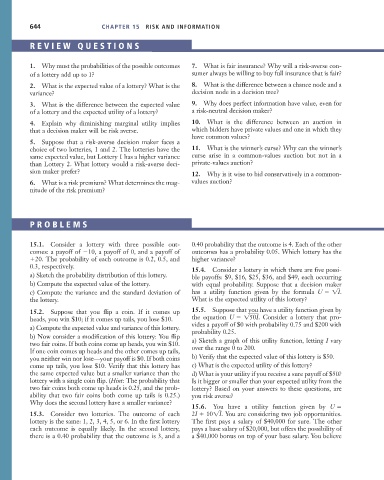Page 670 - Microeconomics, Fourth Edition
P. 670
c15riskandinformation.qxd 8/16/10 11:10 AM Page 644
644 CHAPTER 15 RISK AND INFORMATION
REVIEW QUESTIONS
1. Why must the probabilities of the possible outcomes 7. What is fair insurance? Why will a risk-averse con-
of a lottery add up to 1? sumer always be willing to buy full insurance that is fair?
2. What is the expected value of a lottery? What is the 8. What is the difference between a chance node and a
variance? decision node in a decision tree?
3. What is the difference between the expected value 9. Why does perfect information have value, even for
of a lottery and the expected utility of a lottery? a risk-neutral decision maker?
4. Explain why diminishing marginal utility implies 10. What is the difference between an auction in
that a decision maker will be risk averse. which bidders have private values and one in which they
have common values?
5. Suppose that a risk-averse decision maker faces a
choice of two lotteries, 1 and 2. The lotteries have the 11. What is the winner’s curse? Why can the winner’s
same expected value, but Lottery 1 has a higher variance curse arise in a common-values auction but not in a
than Lottery 2. What lottery would a risk-averse deci- private-values auction?
sion maker prefer? 12. Why is it wise to bid conservatively in a common-
6. What is a risk premium? What determines the mag- values auction?
nitude of the risk premium?
PROBLEMS
15.1. Consider a lottery with three possible out- 0.40 probability that the outcome is 4. Each of the other
comes: a payoff of 10, a payoff of 0, and a payoff of outcomes has a probability 0.05. Which lottery has the
20. The probability of each outcome is 0.2, 0.5, and higher variance?
0.3, respectively.
15.4. Consider a lottery in which there are five possi-
a) Sketch the probability distribution of this lottery. ble payoffs: $9, $16, $25, $36, and $49, each occurring
b) Compute the expected value of the lottery. with equal probability. Suppose that a decision maker
c) Compute the variance and the standard deviation of has a utility function given by the formula U 1I.
the lottery. What is the expected utility of this lottery?
15.2. Suppose that you flip a coin. If it comes up 15.5. Suppose that you have a utility function given by
heads, you win $10; if it comes up tails, you lose $10. the equation U 150I. Consider a lottery that pro-
vides a payoff of $0 with probability 0.75 and $200 with
a) Compute the expected value and variance of this lottery.
probability 0.25.
b) Now consider a modification of this lottery: You flip
two fair coins. If both coins come up heads, you win $10. a) Sketch a graph of this utility function, letting I vary
If one coin comes up heads and the other comes up tails, over the range 0 to 200.
you neither win nor lose—your payoff is $0. If both coins b) Verify that the expected value of this lottery is $50.
come up tails, you lose $10. Verify that this lottery has c) What is the expected utility of this lottery?
the same expected value but a smaller variance than the d) What is your utility if you receive a sure payoff of $50?
lottery with a single coin flip. (Hint: The probability that Is it bigger or smaller than your expected utility from the
two fair coins both come up heads is 0.25, and the prob- lottery? Based on your answers to these questions, are
ability that two fair coins both come up tails is 0.25.) you risk averse?
Why does the second lottery have a smaller variance?
15.6. You have a utility function given by U
15.3. Consider two lotteries. The outcome of each 2I 101I. You are considering two job opportunities.
lottery is the same: 1, 2, 3, 4, 5, or 6. In the first lottery The first pays a salary of $40,000 for sure. The other
each outcome is equally likely. In the second lottery, pays a base salary of $20,000, but offers the possibility of
there is a 0.40 probability that the outcome is 3, and a a $40,000 bonus on top of your base salary. You believe

